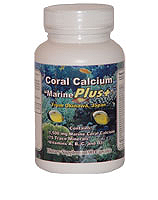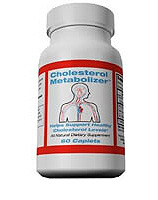Menu
-
About Seaweed
- What is Seaweed?
- Seaweed History
- Seaweed Benefits
- Seaweed Contains Virtually No Oxalates
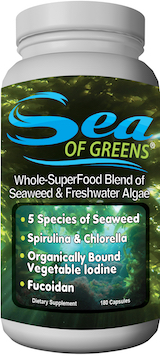
The Healthiest Cultures in the World, Eat Seaweed Everyday.
Everyone wants to be healthy and most people know that that in addition to living a healthy lifestyle and getting regular exercise, the key to maintaining optimal health is getting proper nutrition through a healthy diet and a sensible supplementation protocol.
The healthiest cultures in the world, eat seaweed on a daily basis. This practice is very prevalent in the eastern cultures, but not so much in the western world. The health of westerners often pales in comparison to that of their eastern culture counterparts, who consume seaweed and take whole food supplements daily.
What is Seaweed?
Seaweed comprises a diverse group of organisms (known as macroalgae), that grow in the sea. These sea plants appear similar to land plants, however they lack the complex reproductive structure (flowers) and functional tissues (roots, stems and leaves) that land plants have. Unlike, many land-based vegetables, sea vegetables contain virtually no oxalates!
In general, seaweeds are divided into three groups based on their color:
- Brown Seaweed (Phaeophyta):
- Brown seaweed (also known as Kelp) contains approximately 1,500 species, and comprises the largest and most complex body structure of any other algae.
- Most species are marine and benthic (attach to the ocean floor or other hard surface). The stem-like stipe on each side is lined with large leaf-like structures (blades); the stipe and blades are collectively known as the frond. Gas-filled bladders cause the upper end of the stipe to float on the ocean surface.
- Kelp grows in underwater "forests" (kelp forests) in shallow oceans, and is thought to have appeared in the Miocene, 23 to 5 million years ago. The organisms require nutrient-rich water with temperatures between 6 and 14°C (43 and 57 °F). They are known for their high growth rate, with some varieties growing as much as a half a meter a day, ultimately reaching 30 to 80 meters (100 to 260 ft).
- Kelp is a rich source of both fucoidan and organically bound iodine.
- Green Seaweed (Chlorophyta):
- Green seaweed comprises over 7,000 species. While most are marine, many can be found in fresh water, along both rocky and sandy beaches. Some green seaweeds tolerate low-salinity colonizing areas where rivers meet the sea. Green algae range from the single-celled to moderately complex structures.
- Red Seaweed (Rhodophyta):
- Red Seaweed Consists of more than 4,000 species and grow in marine environments. Not as large as brown algae, the red seaweed body (thallus) is built of complex, branched filaments. Red are benthic, but their distinctive combination of photosynthetic pigments allows them to survive in deeper water. Some species secrete calcium carbonate, which significantly contributes to coral reefs.
Seaweed History
Seaweed has been used since 2700 BC in China. In 600 BC, Sze Teu wrote that in China seaweed was made for special guests or kings. In 300 BC, Chi Han wrote a book about seaweed. Kelp was used in the 5th century for food, and Laminara japonica was imported from Japan in the 5th century.
The Japanese have used seaweed for many years. For over 2000 years, seaweed has been used as a supportive food in the Japanese diet. Six types of seaweeds were used in 800 A.D. in everyday cooking in Japan. In 794, Japanese people used seaweed to make nori, which is a dried sheet of seaweed.
Europeans used Mediterranean seaweed as an herbal medicine. As early as 100 BC, the Greeks collected seaweed. All along the Mediterranean coast, red algae were used as sources of dying agents and as a medicine to treat parasitic worms since pre-Christian times.
Hawaiians and other Polynesian societies grew kelp farms. They used 60-70 species of seaweed for food, medicinal purposes, and ceremonies.
Read LessSeaweed Benefits
One of the Earth's greatest treasures lies beneath the seas and lakes of the world. Research has proven that the waters of our oceans contain some of the richest known sources of mineral elements. The moving forces of nature, through rain, erosion and rivers, has brought all the valuable vitamins of the earth to the sea floor.
These vast sources of nutrition may become much more important than any of us now realize. Land degradation, pollution and over farming has had a drastic affect on the soil. Most commonly, it is from the soil that we derive our minerals and vitamins from the fruits and vegetables we eat. If this food grown on land can no longer give us all the nutrients we require, we must turn to the rich vegetation of the sea, seaweed.
Sea Vegetation, the keystone of the food chain, offers us the nutrients we can no longer gain from land grown crops.
Seaweed Contains Virtually No Oxalates!
These days, many health conscious people consume “green smoothies” or fruit/vegetable supplements in an effort to eat “clean” and maintain good health. Ironically, by doing so, they are actually sabotaging their health, because the most common ingredients in these “green smoothies” and supplements are spinach, kale, Swiss chard, celery, carrot, beets, sweet potato, raspberries and almonds . . . all of which are loaded with oxalates.
The latest research has shown that these high oxalate fruits and vegetables (previously thought to be healthy superfoods) can actually be quite harmful to health due to the sharp, spiky and destructive oxalate crystals that form in the body as a result of consuming them (see image of oxalate crystals below).
Sea of Greens®, which contains sea vegetables and fresh water algae, has virtually no oxalates.
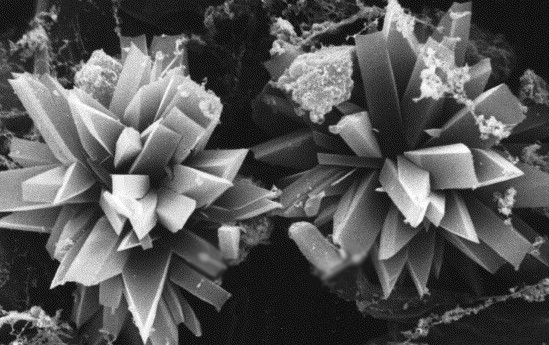
-
Oxalates are substances that plants produce, which are essential to their growth, reproduction and survival.
- They function as a defensive weapon, protecting the plant from being eaten. Plants use oxalic acid’s toxic powers to ward off a variety of predators, such as infectious fungi, insects, and other plant-eating animals, including humans.
- Symptoms of oxalate overload are often accompanied by fatigue or tiredness,
- When oxalic acid chemically bonds to calcium, it can interfere with cell energy production.
- When oxalates bond to iron (in the bone marrow), it can deprive hemoglobin of the iron it needs to carry oxygen throughout the body, resulting in anemia.
- Oxalate overload can also cause the depletion of the antioxidant glutathione,which may result in:
- an impaired ability of the liver to detoxify
- a lower potential to preserve brain health
- Oxalate consumption can also result in heavy metal toxicity.
- although oxalates can chelate many toxic heavy metals (such as mercury and lead) . . .
- unlike other chelating agents, oxalates tend to trap the heavy metals in the tissues.
Oxalate crystals wreak havoc in all of the many places they form in the body, which include: the kidneys, prostate, testes, vagina, blood vessels, lungs, thyroid gland, lymph nodes, bones, joints, muscles, oral tissues, the eyes, the skin, and the brain.
The trending increase in the incidence of calcium oxalate kidney stones, helped launch dietary oxalate research to the forefront. The long overdue attention to this important topic of research was fueled by the clinical observation that calcium oxalate stone formers tend to have elevated oxalate levels in their blood and urine. Although most urologists seem to be clueless about this causative relationship, the connection between dietary oxalate consumption, and the increased risk of forming calcium oxalate kidney stones is undeniable.
Anyone who has ever experienced a kidney stone, can attest to the pain and agony they cause, not to mention the permanent kidney damage that can result (if not resolved in a timely manor) so avoiding their formation, in the first place, by reducing, the consumption of oxalates should, be a goal for everyone with a history of kidney stones.
Excessive dietary oxalate consumption has also been linked to kidney failure, (even in people without a history of kidney stones).
So clearly, the over consumption of dietary oxalates is a risk factor for kidney disease and should be of great concern to all health conscious people.
Other health conditions, which can be brought on by the regular consumption of even moderate levels of oxalate. include: inflamed joints, carpal tunnel syndrome, muscle spasms, fibromyalgia, lipomas, chronic prostatitis (in men), vulvodynia (vulver pain in woman), chronic skin issues, cold hands and feet, brain fog and mood problems.
Some people may experience: shortness of breath, sinus problems, yeast infections, urinary issues (such as urinary tract infections, frequent urination or cloudy urine). and digestive problems (such as reflux disease, Irritable Bowel Syndrome, bloating, excessive belching, and constipation).
Because its so easy to over consume oxalates, many people experience the typical oxalate related aches and pains (such as stiff necks and knots or pain in the top of the shoulders or upper back) but incorrectly attribute them to “normal” aging, rather than to oxalate consumption.
Other issues, which can be indicative of oxalate overload, but are rarely attributed to them include: sensitive skin (often with an unexplained rash), gingivitis and periodontal disease (triggered by excessive tarter on the teeth), dry and/or itchy eyes, floaters in the eye and twitches in the eye,.
Persistent oxalate consumption (over time) can result in the accumulation of oxalates in the body, sometimes without obvious symptoms, but may culminate years later with “old age” problems such as osteoporosis, chronic pain, vision impairment and hearing loss.
If you who want to enjoy the health benefits of smoothies or fruit/vegetable supplements, without subjecting your cells to these sharp, spiky and destructive oxalate crystals, then Sea of Greens® which contains sea vegetables and fresh water algae, having virtually no oxalates, is a great option.
Please follow the links below to learn more about oxalates and their poisonous effects:
Sally K Norton, MPH Is the leading expert on the harmful effects of oxalates in food. Her ground breaking book Toxic Superfoods is a must read!
Jill Harris, LPN, CHC has written extensively about how to reduce oxalates in your diet.
Monique Attinger, MLIS,CHN has compiled a ton of research on the harmful effect of oxalates in our diets.
Not all Sea Vegetable Sources are Equal.
There are other sea vegetable supplement products on the market, some which boast of how many different species of seaweed they contain. While there is something to be said for consuming a diverse selection of seaweed species . . . Much more important than HOW MANY species a product contains, is WHERE the species come from. In today's post Fukushima world, WHERE the raw materials are sourced from could not be more important! What good is having a diverse selection of species, if they are tainted with radiation or other contaminants?
It's true that compared to land plants, we have little control over the growing conditions of our wild marine plants. But we do have choices about how, when, where, and how much we harvest, as well as how the seaweed are transported, dried, stored and packaged.
- Sea of Greens® contains seaweed harvested from the pristine waters of the Northern Atlantic Ocean.
- Sea of Greens®is untainted by radiation, heavy metals, herbicides, pesticides, and microbiological contaminants.
- Sea of Greens® contains fresh harvested sea vegetables, which are low-temperature dried and hand packed with minimal processing.
- Sea of Greens® is certified organic, gluten-free, soy-free, dairy-free and GMO-free by Organic Crop Improvement Association (OCIA)
Sea of Greens® is a unique, 100% natural, Oxalate-free, Whole-Superfood supplement, containing an optimal blend of seaweed and freshwater algae.
- Sea of Greens® contains five species of seaweed, representing all three colors:
- Bladderwrack, Wakame and Rockweed (brown)
- Sea Lettuce (green)
- Dulse (red)
- Sea of Greens® also contains two species of freshwater algae:
- Spirulina (blue-green)
- Chlorella (green)
Sea of Greens® is more potent and nutritionally dense than any land plant food source and contains hundreds of organic phytonutrients, many of which our bodies require to maintain optimal health, but are missing from our normal diets.
Sea of Greens® contains a full spectrum of organic vitamins, trace minerals, lipids, plant sterols, amino acids, omega 3's and 6's, anti-oxidants, growth hormones, polyphenols, flavenoids, and much more. It also contains powerful Fucoidan, Laminarin and Alginate compounds, which are not found in land plants.
Read LessBladderwrack
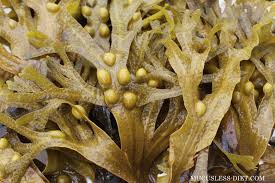
Bladderwrack (Fucus vesiculosus,) aka black tang, rockweed, bladder fucus, sea oak, black tany, cut weed, dyers fucus, red fucus, and rock wrack, is a brown seaweed (kelp) harvested from cool ocean waters around world, easily recognized by its air-filled thalli or "bladders" that keep the plant afloat.
Bladderwrack is one of the highest iodine containing sea vegetables known. The iodine in bladderwrack is present in the form of di-iodotyrosine (DIT) which is a normal precursor of the Thryoid Hormones T4 (Thyroxine) and T3 (tri-iodothyronine). T4 is manufactured by the condensing of DIT and thyroid peroxidase enzyme in the follicular luminae of the thyroid gland. The naturally occurring source of iodine makes Bladderwrack a great choice in the support of a healthy functioning thyroid gland, when more iodine is required for optimal function.
Also of interest is the high amount of fucoidin found in Bladderwrack. Fucoidans and Fucans are sulfated polysaccharides found in most brown seaweeds. These substances have been researched for modulating a healthy inflammatory response, and have shown strong properties for supporting a healthy immune system and intestinal flora.
Bladderwrack is also recognized as a source of other naturally occurring minerals such as iron, zinc, magnesium, potassium, calcium, magnesium, potassium, sodium, sulfur, silicon and iron and is also high in some B-complex vitamins. It contains moderate amounts of phosphorus, selenium, manganese and zinc and small amounts of vitamins A, C, E and G. Bladderwrack also contains anti-sterility vitamin S as well as vitamin K. It is rich in algin and mannitol, carotene and zeaxantin with traces of bromine.
Read LessWakame
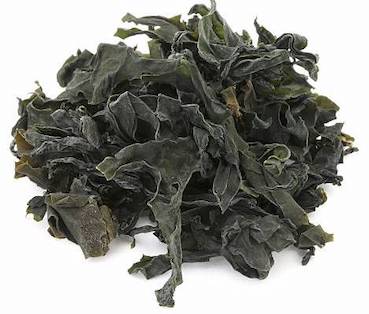
Wakame has long been known to be a delicious, healthy food. In Korea, it is given to mothers after they give birth to replenish the nutrients lost during the gestation and delivery. In Japan, the people of Okinawa have the highest per capita consumption of seaweed, the lowest rates of cancer, and a higher life expectancy of all Japanese prefectures. And Japan itself has the some of the highest life expectancy amongst all countries. There are over 100 medical studies that link seaweed, and Wakame in particular, to better health - and all this without any synthetic or toxic chemicals.
Wakame has traditionally been cultivated by growing it on ropes tied to offshore rafts. It's mainly the seaweed "leaves" or blades that are harvested. However, all parts of the plant, except the root, are used. These can be eaten raw or cooked and can be added to soups and salads to give them that extra "umami" or savory taste. Yet it's only about 13 calories per 30 g of raw seaweed.
That tiny calorie content in Wakame is due to its low levels of fat and carbohydrates. It's also rich in vitamins and minerals. The USDA National Nutrient Database gives a complete nutritional profile of Wakame; the list of nutritional benefits includes vitamin A, vitamin C, vitamin E, vitamin K, niacin, pantothenic acid, phosphorus, riboflavin, folate, calcium, iron, magnesium, manganese and copper. One note of caution is that Wakame also contains a high amount of sodium. It is important to soak the wakame thoroughly to reduce the amount of salt used to preserve it during storage and transportation.
Wakame is a an exceptional source of the following nutrients:
- Magnesium
- Critical in the contraction and relaxation of muscles
- Controls the function of certain enzymes in the body
- Involved in the production & transport of energy and the production of protein.
- Iodine
- Needed for metabolism of cells - the process of converting food into energy
- maintains the balance of the thyroid gland and is needed for the production of thyroid hormones.
- Most people (as many as 80%) in the developed world suffer from mild iodine deficiency. This deficiency is often undiagnosed and leads to a variety of systemic diseases.
- Iodine deficiency gives rise to hypothyroidism, symptoms of which are extreme fatigue, goiter, mental slowing, depression, weight gain, and low basal body temperatures.
- Calcium
- Wakame is a very bioavailable source for of calcium. Each 100 grams of raw wakame contains 150 milligrams of calcium, which is needed for strong healthy bones.
- Iron
- Wakame is very rich in iron, a mineral which is essential for the production of red blood cells
- Vitamins
- Vitamins A, C, E, and K. These vitamins are all amazing for skin health and repair as well as immunology.
- Vitamin D. Promotes the absorption of calcium for healthy bones and enhances the nerve, muscle, and immune systems.
- Riboflavin (Vitamin B2). We need riboflavin to use the carbohydrates, fats, and proteins in the foods we eat. Riboflavin helps us use these nutrients for energy in our bodies for growth and is also necessary for red blood cell production. Riboflavin functions as an antioxidant and works in the body with other vitamins such as niacin, folate, and vitamin B6.
- Folate (Vitamin B9). Helps the body make new cells and is especially important for pregnant women. Wakame contains 200 mcg in a 100mg serving - which is 50% of our daily requirements.
- Lignans, a phytonutrient rich in antioxidants and thought to help regulate hormone levels and support the immune system.
Rockweed
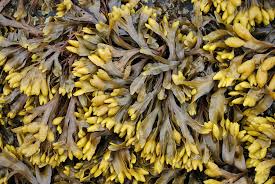
Rockweed (Ascophyllum nodosum) is common large brown seaweed, dominant on sheltered rocky shores. The species has long strap like fronds with large egg-shaped air bladders at regular intervals. The fronds of Ascophyllum nodosum are typically between 0.5 and 2m in length.
The inflated bulbs at the end of the blades along with a midrib in the blade are major distinguishing characteristics of rockweed. The bulbs are filled with air and mucilage that allows the blades to float exposing them to sunlight and allowing water to move through the branches.
The bumps on the bulbs are reproductive structures called pits or conceptacles. Special cells within the pits produce eggs and sperm which are released into the water column and fuse producing a baby plant. The new plant then grows directly into an adult. Reproduction occurs through the year. Other seaweeds have a more complicated reproduction cycle where one form produces eggs and sperm while another form produces spores.
The plants drift in large, spherical masses in sheltered waters, grow slowly and can live to be several decades old. Individual fronds can become up to 15 years old before breakage.
Read LessSea Lettuce
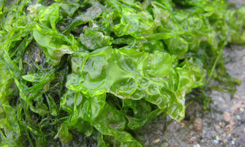
Sea lettuce (Ulva lactuca) is a bright green algae composed of lobed, ruffle-edged leaves with a broad translucent frond that is just 2 cell layers thick. It has a rather "crumpled" appearance and is reminiscent of a lettuce leaf, hence the common name. Its leaves are often perforated with holes of various sizes. Almost no stalk exists at the point of attachment, and no true roots are present.
Despite looking flimsy sea lettuce is quite strong for leaves only two cells thick and can easily be harvested, in or out of the water. Sea lettuce is the greenest seaweed you will ever see. When dried by the sun, its color can range from white to black.
The sea lettuces are widely distributed along the cool water coasts of the world's oceans and are eaten by a number of different sea animals, including manatees and the sea slugs. Sea lettuce may be found attached to rocks and shells by a holdfast, but it is also commonly found free floating. Among the most common of the shallow water seaweeds, sea lettuce is often found in areas of exposed rocks and in stagnant tide pools. Sea lettuce has also been recorded at depths of 75 feet or more. Sea lettuce grows in both high and low intertidal zones and marshes throughout the year.
There are ten species of sea lettuce, all of which are edible and and a good food source for humans. Sea lettuce is high in protein, soluble dietary fiber, and a variety of vitamins and minerals, especially iron and calcium. It is usually eaten raw in salads and cooked in soups. It can also be used as a substitute for nori, a seaweed used in sushi.
Nutritionally Sea lettuce is very high in iron and protein (similar to dulse), and is high in iodine, aluminum, manganese and nickel as well. Like most of our sea veggies, sea lettuce provides considerable amounts of dietary fiber (31%). Since our sea veggies are low temp dried in the sun, sea lettuce enzymes are still active.
Read LessDulse
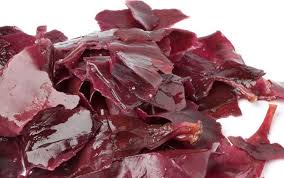
Dulse (Palmaria palmata) is a red alga (Rhodophyta), which typically grows on the northern coasts of the Atlantic and Pacific oceans. Dulse grows attached by its discoid, holdfast to the stripes of Laminaria or to rocks. It has a short stipe and the fronds are variable in colour, from deep-rose to reddish-purple and are rather leathery in texture.
Dulse is a well-known snack food. In Iceland, where it is known as söl, it has been consumed throughout the centuries, and is an important dietary source of protein, fiber, potassium, iron and iodine. Dulse is also a good source of vitamins and trace minerals, containing all trace elements needed by humans. Dulse is used as fodder for animals in some countries.
Fresh dulse can be eaten directly off the rocks before sun-drying. Sun-dried dulse is eaten as is or is ground to flakes or a powder. In Iceland the tradition is to eat it with butter. It can be pan fried quickly into chips, baked in the oven covered with cheese, with salsa, or simply microwaved briefly. It can be used in soups, chowders, sandwiches and salads, or added to bread/pizza dough. Finely diced, it can be used as a flavour enhancer in meat dishes, such as chili, in place of monosodium glutamate.
Dulse is perfect in CHOWDERS, especially prized by vegetarians for its rich seafood flavor. It also goes well in any vegetable STIRFRY.
Dulse is considered a superfood because of its high iodine and potassium content, plus a long list of micro-nutrients and phytochemicals and for it's proven antioxidative properties.
Read LessSpirulina
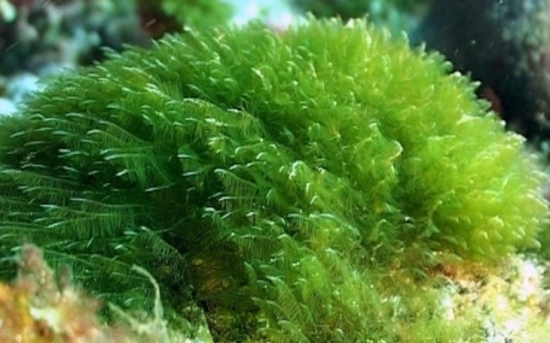
Spirulina (Arthrospira platensis) is a simple, one-celled, blue-green algae, that belongs to the cyanobacteria family of bacteria. It gets it's name from the Latin word for "helix" or "spira", because of its spring-like physical characteristic.
There are two species of spirulina . . . Arthrospira platensis and Arthrospira maxima, both of which are consumable by humans and other animals. Spirulina is cultivated worldwide; used as a dietary supplement as well as a whole food; and is available in tablet, flake and powder form. It is also used as a feed supplement in the aquaculture, aquarium and poultry industries.
Spirulina occur naturally in tropical and subtropical lakes with high pH and high concentrations of carbonate and bicarbonate. Most cultivated spirulina is produced in open channel raceway ponds, with paddle-wheels used to agitate the water. The largest commercial producers of spirulina are located in the United States, Thailand, India, Taiwan, China, Bangladesh, Pakistan, Burma (a.k.a. Myanmar), Greece and Chile.
Dried spirulina contains about 60% protein. It is a complete protein containing all essential amino acids, though with reduced amounts of methionine, cysteine and lysine when compared to the proteins of meat, eggs and milk. It is, however, superior to typical plant protein, such as that from legumes.
Spirulina's lipid content is about 7% by weight, and is rich in gamma-linolenic acid (GLA), and also provides alpha-linolenic acid (ALA), linoleic acid (LA), stearidonic acid (SDA), eicosapentaenoic acid (EPA), docosahexaenoic acid (DHA) and arachidonic acid (AA). Spirulina contains vitamins B1 (thiamine), B2 (riboflavin), B3 (nicotinamide), B6 (pyridoxine), B9 (folic acid), vitamin C, vitamin A and vitamin E. It is also a source of potassium, calcium, chromium, copper, iron, magnesium, manganese, phosphorus, selenium, sodium and zinc. Spirulina contains many pigments which may be beneficial and bioavailable, including beta-carotene, zeaxanthin, chlorophyll-a, xanthophyll, echinenone, myxoxanthophyll, canthaxanthin, diatoxanthin, 3'-hydroxyechinenone, beta-cryptoxanthin and oscillaxanthin, plus the phycobiliproteins c-phycocyanin and allophycocyanin.
Read LessChlorella
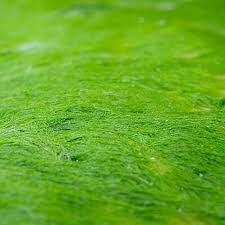
Chlorella (Chlorella Vulgaris) is a high-protein freshwater micro-alga that was one of the first lifeforms on earth. It has the highest chlorophyll content amongst all plants known and is a genus of single-cell green algae, belonging to the phylum Chlorophyta. The name Chlorella is taken from the Greek word "chloros", meaning green, and the Latin diminutive suffix "ella", meaning small.
Chlorella is spherical in shape, about 2 to 10 microns in diameter, and is without flagella. It contains both of the green photosynthetic pigments chlorophyll-a and chlorophyll--b in its chloroplast. Through photosynthesis, it multiplies rapidly, requiring only carbon dioxide, water, sunlight, and a small amount of minerals to reproduce.
Chlorella is considered a superfood, because it is high in protein and other essential nutrients. When dried, it is about 45% protein, 20% fat, 20% carbohydrate, 5% fibre, and 10% minerals and vitamins. It is also abundant in calories and vitamins.
Chlorella also supports healthy detoxification. Due to it's small size, unique molecular structure and being rich in chlorophyll, ingested chlorella bonds to metals, chemicals and some pesticides and in doing so helps support our body in eliminating these unwanted metals and toxins.
Moroever, Chlorella is uniquely designed to NOT bind to the minerals our body needs to function optimally. It does not bind to beneficial minerals like calcium, magnesium, or zinc. It's almost as if chlorella knows which metals belong in our body and which chemicals need to be removed.
Chlorella is one of the most widely studied food supplements in the world. Aside from being the subject of medical research in the USA, USSR, Germany, Japan, France, England and Israel, chlorella has been extensively studied as a food source since it is made up of a whopping 50 percent protein and is considered a complete amino acid-based food. Even NASA has studied using chlorella as the one of first whole foods in space on the international space station!
Under certain growing conditions, Chlorella yields oils that are high in polyunsaturated fats. Chlorella minutissima has yielded EPA at 39.9% of total lipids.
Not All Chlorella is Created Equal
Unlike many food supplements, chlorella has one unique feature that makes the manufacturing process one of the primary concerns when considering a source. Chlorella is completely indigestible by humans. We simply do not have the enzymes to break down its cell wall.
Simply chewing and digesting chlorella, will not release the powerful health benefits it offers. This is because chlorella's tough outer cell wall, which is also chemically responsible for binding with the toxins inside our bodies, cannot be broken down by humans.
It is therefore, imperative that the manufacturing process break down the tough outer cell wall for us (resulting in "Broken Cell Chlorella"), as this is the only way to make the chlorella biologically available to our bodies.
Another concern when choosing which chlorella to use is the source water where it is grown and harvested. Since chlorella is a natural green food, it will be affected by polluted water and will retain environmental toxins if it's grown in contaminated waters.
The chlorella contained in Sea Of Greens™uses a broken cell technology using a milling process that eliminates light and heat to preserve nutrients.
Read LessFucoidan
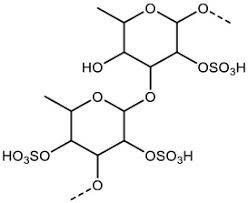
Fucoidan is a marine algal polysaccharide found in the cell walls of many brown seaweeds (kelps). It is mainly found in various species of brown algae and brown seaweed such as mozuku, kombu, limu moui, bladderwrack, wakame, and hijiki. Variant forms of fucoidan have also been found in animal species, including the sea cucumber. There are at least two distinct forms of fucoidan: F-fucoidan, which is 95% composed of sulfated esters of fucose, and U-fucoidan, which is approximately 20% glucuronic acid.
In recent years, scientific interest has intensified around fucoidan. Some studies have suggested that fucoidan may help promote healthy immune function. particularly the support of bone marrow cells (BMCs), which are the main cellular reservoir for the hematopoietic and immune system, but which can be damaged when exposed to radiation.
Many experts now believe fucoidan is one of the key nutrients responsible for the exceptionally long, healthy lives enjoyed in Okinawa, Japan, where fucoida is part of the daily diet and where there is the world's highest concentration of centenarians.
Read LessFucoxanthin

Fucoxanthin is a type of carotenoid (xanthophyll) with the formula C42H58O6 and occurs naturally in edible brown seaweed and to a lesser degree in red and green seaweed as well. It is found as an accessory pigment in the chloroplasts, which accounts for their brown or olive-green color.
Fucoxanthin is the subject of many clinical studies looking into potential effects on metabolism, energy expenditure, blood pressure, serum lipid levels and liver enzymes. Other studies are studying potential anti-inflammatory, antinociceptive, and anti-cancer properties.
Organically Bound Iodine
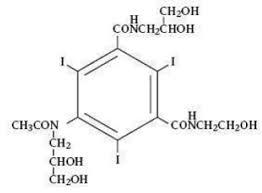
The single most important element provided by seaweeds is iodine, which is more abundant in seaweeds, than in any land based plants or animals.
All vertebrates require iodine, which the thyroid gland uses to produce the thyroid hormone, triiodothyronine (T3) and its pro-hormone, thyroxine (T4). The thyroid hormones are primarily responsible for regulation of metabolism. This function is vital for life, thus iodine is critical for maintaining good health.
When vertebrates lived in the sea, even at about 60 ppb, there was a constant reliable source of iodine. Since some vertebrates left the sea, obtaining enough iodine has been a challenge to their descendants, including ourselves.
Since no land plants require iodine, their taking it in from roots or leaves may be just incidental. That has meant that few land plants are reliable or even adequate iodine sources, unless consumed in large quantities. Eating 3-5 grams of most dried, unrinsed seaweeds will however provide the RDA of 100-150 micrograms.
In adult humans, chronic low iodine consumption often results in first, goiter, an enlargement of the thyroid gland, deliberately generated by TSH (thyroid-stimulating Hormone) to increase thyroid gland cell surface area and more "iodine traps", and secondly, various manifestations of hypothyroidism. The treatment is often simply more dietary iodine for both conditions, which can be easily accomplished by consuming dietary seaweeds.
Since the dawn of the nuclear age, iodine has taken on even more importance. When Uranium is used in nuclear fission, one of the decay products is Iodine 131. That means not only nuclear weapons and bombs, but also, all of the controlled nuclear events with nuclear reactor fuel rods, release radioactive Iodine 131 into the atmosphere. We are all continually and erratically dusted with Iodine 131 every day of every year.
Additionally, nuclear disasters such as Three-mile Island in USA, Chernobyl in Ukraine and Fukushima in Japan all released enormous quantities of Iodine 131 into the atmosphere. Since then, millions of iodine 131-induced thyroid diseases have been reported worldwide, starting shortly after each event and continuing through today.
Relatively rare 20 years ago, and unknown prior to 1945, thyroid cancer is now the number one cancer in children. The prevalence of thyroid cancers in both adult men and women is increasing at an alarming rate.
Iodine 127 is the only natural isotope of iodine and it is very stable, unlike Iodine 131 which is very unstable and decays with the release of a high energy Beta particles, which wreak havoc on any tissue it comes in contact with. The reason Iodine 131 is so hazardous is because our bodies will happily take it in if we need iodine. Furthermore, Since prior to the human atomic age there was no iodine 131, we have not evolved to the point of developing any natural defense against it.
If we have sufficient Iodine 127 in our bodies, our bodies will not take in the heavier iodine 131, but if we are deficient, our thyroids will take it up and will likely develop cancers.
Potassium Iodide (KI) and Potassium Iodate (KIO3) are good sources for iodine 127, should a nuclear emergency arise. However, neither is recommended to take on a daily basis. Both can have side effects, could be overdosed on and could potentially be dangerous in general.
It is far better to take an organic source of iodine. There is no better organic source than seaweed, which contains organically bound iodine. The organically bound iodine in seaweed is far more bioavailable than KI or KIO3, and it can be consumed everyday with no problem. if we continually take in 150 micrograms of iodine 127 daily (accomplished by consuming 3-5 grams of seaweeds daily), we will most likely be protected from iodine-deficiency. and thus protected from iodine 131.
Read LessSea of Greens ® Packages
Contains:
180 capsules per bottle (30 day supply)
Suggested use:
As a dietary supplement for adults, take six capsules per day
(preferably three capsules, twice per day).

- 1 bottle
- $41.95
- 2 bottles $40.95 each
- $81.90
- 3 bottles $39.95 each
- $119.85
- 6 bottles $38.95 each
- $233.70
- 12 bottles $37.95 each
- $455.40
Sea of Greens® Supplement Facts
| Serving Size: 3 Capsules
Servings per container: 60 |
||
| Amount per 2 Servings (suggested daily usage) | % Daily Value | |
|---|---|---|
| Bladderwrack (Fucus Vesiculosis) | 750 mg | * |
| Wakame (Alaria Esculenta) | 675 mg | * |
| Rockweed (Ascophyllum Nodosum) | 200 mg | * |
| Sea Lettuce (Ulva Lactuca) | 35 mg | * |
| Dulse (Palmaria Palmata) | 35 mg | * |
| Spirulina (Arthrospira Platensis) | 1,050 mg | * |
| Chlorella (Chlorella Vulgaris) | 1,050 mg | * |
Other ingredients: 100% Vegetable capsule, L-Leucine
Directions
As a dietary supplement for adults, take six capsules per day
(preferably three capsules, twice per day).
Disclaimer
Statements contained herein have not been evaluated by the Food and Drug Administration. These products are not intended to diagnose, treat and cure or prevent disease. Always consult with your professional health care provider before changing any medication.
Other Products Available from: NHS Global Distributors LLC
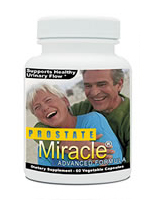
Prostate Miracle®
Trusted by thousands to support healthy urinary flow and prostate health.
read more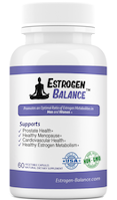
Estrogen Balance®
A natural formula for Men & Women, combining: D.I.M., Quercetin and Flaxseed.
read more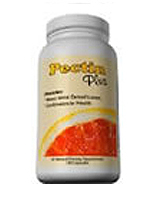
Pectin Plus®
Supports healthy detoxification, healthy blood pressure, healthy cholesterol levels and prostate health
read moreInformation
Contact
Suite 102, PMB 128
Saint Johns, FL 32259
International: 1.805.322.0005
Thank you for visiting Sea-of-Greens.com
This information here within is designed to provide accurate information in regard to the subject matter covered. It is provided with the understanding that NHS Global Distributors LLC is not engaged in rendering medical advice. If expert assistance is required, the services of a competent medical professional should be sought. These statements have not been evaluated by the Food and Drug Administration. These products are not intended to diagnose, treat, cure or prevent any disease. Always read and follow manufacturer's directions that come with this product.
You are protected by the FDA Dietary Supplement and Nonprescription Drug Consumer Protection Act
please call 877.965.2140 or Click here to report any Adverse Reaction with Sea of Greens.






